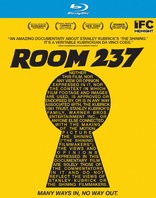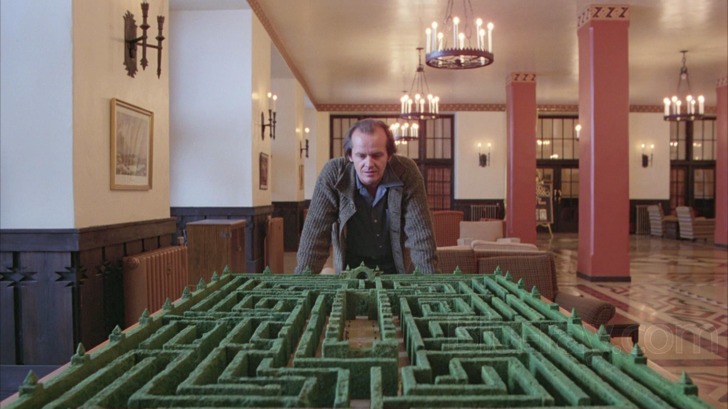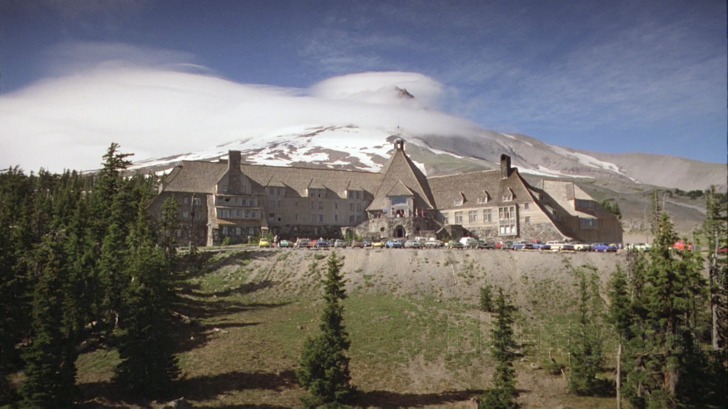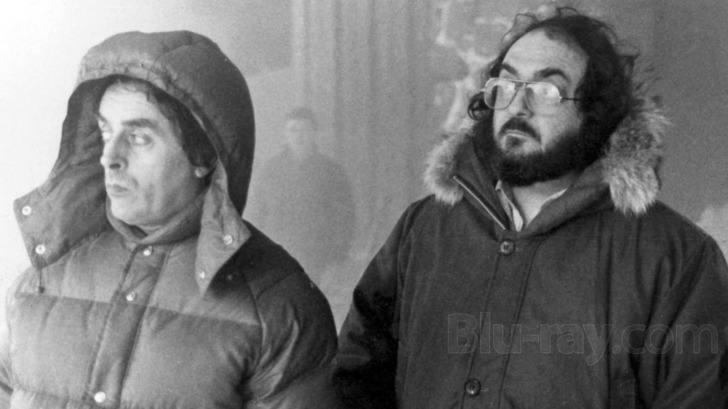Room 237 Blu-ray Movie
HomeRoom 237 Blu-ray Movie 
IFC Films | 2012 | 102 min | Not rated | Sep 24, 2013
Movie rating
6.2 | / 10 |
Blu-ray rating
| Users | 0.8 | |
| Reviewer | 3.5 | |
| Overall | 2.8 |
Overview
Room 237 (2012)
A subjective documentary that explores the numerous theories about the hidden meanings within Stanley Kubrick's film The Shining (1980).
Starring: Jack Nicholson, Shelley Duvall, Danny LloydDirector: Rodney Ascher
| Documentary | 100% |
Specifications
Video
Video codec: MPEG-4 AVC
Video resolution: 1080p
Aspect ratio: 1.78:1
Original aspect ratio: 1.78:1
Audio
English: DTS-HD Master Audio 5.1
English: LPCM 2.0
Subtitles
English SDH, Spanish
Discs
50GB Blu-ray Disc
Single disc (1 BD)
Playback
Region A (C untested)
Review
Rating summary
| Movie | 3.5 | |
| Video | 3.5 | |
| Audio | 3.5 | |
| Extras | 3.0 | |
| Overall | 3.5 |
Room 237 Blu-ray Movie Review
WHAT does it mean? What DOES it mean? What does IT mean? What does it MEAN?
Reviewed by Casey Broadwater September 26, 2013It's doubtful anyone has ever called The Shining "just another horror film." To many, Stanley Kubrick's 1980
adaptation of Steven King's good-but-not-great novel—about a writer driven to madness after accepting a caretaker job at a
mountain resort—is the horror film, near totemic in its stature within the genre. For reasons not immediately
expressible, The Shining has a mythic, timeless quality, as if it exists independent of cinema itself. Sure, there's
Kubrick's use of fearful symmetry, Jack Nicholson's big-bad-wolf performance, and the now-iconic catchphrases of "REDRUM!"
and "Heeeeere's Johnny!" and "Come and play with us, Danny," but these are merely parts of the film's surface allure. It
lingers in our minds—haunts might be a better word—because it seems to have a much deeper resonance.
Thirty-three years after it premiered, The Shining continues to be discussed and debated by both film scholars and
crackpot conspiracy theorists, all intent on exposing hidden symbolism, making overlooked thematic connections, and sussing
out Kubrick's esoteric intent. Like 2001: A Space Odyssey, the movie invites endless interpretation, and while the idea
that there's one "right" answer is anathema to postmodern critical theory, some takes are certainly better—i.e., more fully
formed and "believable"—than others. Room 237, a new documentary about these varied dissections of The
Shining, spans the hermeneutical gamut—from reasonably cogent argumentation to frothing wingnuttery—and director
Rodney Ascher refuses to editorialize, letting the comments of his interview subjects speak for themselves. This will likely
frustrate those who would want Room 237 to be a definitive map, guiding us through The Shining's labyrinth
of meaning. Instead, we get an ever deepening fractal with endless subjective tangents—a commentary not so much on
The Shining itself, but on the maddening possibilities of poststructuralist, anything-goes criticism.

Avoiding the "talking head" trap of many critical-leaning documentaries, Ascher uses only repetitive clips from the film and illustrative archival footage, strictly relegating the interviewees to audio commentary. They're a diverse lot, and their individual approaches to the The Shining are singularly obsessive. The most convincing of the bunch is ABC News correspondent Bill Blakemore, who presents a compelling case that the film—beneath the horror movie trappings—is essentially a commentary on Manifest Destiny, the genocide of Native Americans, and the ease with which we forget the past and are thus doomed to repeat it. Related is Albion College history professor Geoffrey Cock's assertion that The Shining contains a strong sub-text on the Holocaust, pointing out—among other things—the numerous instances of the number "42," which was the year in which Hitler implemented his Final Solution. The wider implication, of course—and both men would probably agree here—is that the film is a way of indirectly confronting the horrific mistreatment of all subjugated minorities. The Shining's more overt hints of racism and imperialism—see Nicholson's "White Man's Burden" reference when talking with Lloyd, the ghostly bartender—are just gateways to further exploration of these themes, which appear in a strategic pattern of intercultural symbolism.
If only all of the theorists Ascher has assembled were so insightful. The other three hold limited interest, with ideas that are cool but not particularly useful, half-baked, or else completely ridiculous. In that order: Musician/curator John Fell Ryan once organized an experimental screening of The Shining where the film was simultaneously projected forwards and backwards. This results in some interesting juxtapositions—like Jack Nicholson's maniacal face morphing into a clown crying blood tears when overlaid with the image of the murdered Grady twins—but this seems more like fodder for a novelty Tumblr blog than any real analysis. Novelist Juli Kearns initially offers a fascinating look at the "impossible" layout of the Overlook Hotel—see the window in the manager's office, which has no business being there—but her comments increasingly veer into the weird pointing out of personal, William Burroughs-esque synchronicities, like when her son described to her a dream that happened to pertain in some loose way to the particular scene that she was watching at the time. And finally, we have the elaborately constructed but totally bonkers assessment of Jay Weidner, a moon landing "truther" convinced that The Shining is Kubrick's cryptic admission that he was hired by the government to fake the Apollo 11 mission. Mr. Weidner's other interests, according to his website, include Nostradamus, "The Denver Airport Mystery," and alchemical traditions. So, yeah.
Considering how much of substance there is to say about The Shining, it's somewhat off-putting at first that Ascher would lump Weidner's nonsense in with the comparatively grounded hypotheses of the other commentators. But by the end of the film, we understand the director's point. Room 237 isn't primarily a documentary about how to read The Shining; it's an assessment of how films now—in the age of YouTube, blogs, and online forums—are being watched and assessed, picked apart and shared and reinvented. The Shining is just a sterling example of the plurality of approaches available to today's obsessive cinephile. Ascher could've just as easily gone with Mulholland Drive. Or Last Year at Marienbad. Or any film that, in its ambiguity and critical open-endedness, provokes a response.
There is an interesting contradiction here, though, that is Kubrick-centric. Given the director's reputation as notoriously detail- oriented, most of the interviewees imbue him with a Pope-like sense of infallibility, as if Kubrick never made mistakes, always knew exactly what he was doing in every frame, and had clear purposes for the minutest of on-screen choices. While their means of evaluating the film may be poststructuralist—in that they all tend to read whatever the hell they want into the movie, using their own highly specified methods—they also fall back on structuralist assumptions about directorial authority and intent. Is it likely that the chair that goes missing in the background from one shot to the next means something, or is it more likely that it was a simple continuity error? What Ascher is asking in Room 237 takes a meta-step back: Can the missing chair have meaning even if it was only a continuity error?
Room 237 Blu-ray Movie, Video Quality 

Assembled from a wide variety of materials, both standard and high definition, Room 237's 1080p/AVC-encoded presentation is a total picture quality hodgepodge. The principal source is The Shining, of course, and thankfully, the footage from the film here doesn't look any different from Warner Bros. Blu-ray edition, albeit perhaps with a bit more compression. The color balance and the general level of clarity seem the same. Outside of The Shining, though, anything goes. Clips from 2001: A Space Odyssey and Eyes Wide Shut look fine, while excerpts from Paths of Glory are a muddled, macroblocking-ridden mess. And so it goes. A lot of the archival footage—vintage news reels, Nazi marches, old cartoons—look as though they were ripped straight from a 360p YouTube stream, while other bits and bobs are sharp and well-defined. The most I can really say here is that IFC's Blu-ray is probably true to the source materials—it adds no undue compression or other artifacts—and that there's enough high definition footage here to make a Blu-ray purchase preferable to DVD.
Room 237 Blu-ray Movie, Audio Quality 

IFC gives us two audio options here, a lossless DTS-HD Master Audio 5.1 surround track and an uncompressed Linear PCM 2.0 stereo mixdown. I actually found I preferred the stereo mix, as the score in the multichannel offering seems a bit too loud in the rear speakers at times, potentially distracting from the commentary. But damn—what a score. Musicians/composers Jonathan Snipes and William Hutson have created a pitch-perfect imitation of a late 1970s, early 1980s-style horror score, drawing heavily on the influence of Goblin and Tangerine Dream, John Carpenter and Wendy Carlos. (Expect lots of synthesizer lines.) The music sounds great, but many of the audio interviews sound as though they were recorded via Skype or at home using an in-computer microphone. Still, everything is generally easy to understand. The disc includes optional English SDH and Spanish subtitles.
Room 237 Blu-ray Movie, Special Features and Extras 

- Audio Commentary: This is like watching an entirely different film. Blogger and Kubrick expert "MSTRMND"— real name: Kevin McLeod—was offered the opportunity to give his views in the documentary, but he declined because he didn't want to appear side-by-side with conspiracy theorists. After watching the film, though, and seeing what the Ascher was really out to accomplish—comment on the new ways that people watch and obsess over movies—McLeod agreed to do a full-length audio commentary. Let me just say that his insights are by far more credible and well thought out than anyone in Room 237 proper, drawing on his knowledge of neuroscience, cognitive development, and comparative mythology. Worth the price of the disc alone.
- Secrets of The Shining: Live from the First Annual Stanley Film Festival (HD, 50:19): A great panel discussion with Ascher, Jay Weidner, The Shining TV-miniseries director Mick Garris, and Kubrick's longtime friend and former assistant, Leon Vitali, who rips Weidner's moon conspiracies to shreds.
- Deleted Scenes (HD, 23:51): Eleven additional audio interview sequences, presented as a screen capture of the audio files playing in the director's Adobe Premiere program.
- The Making of the Music (HD, 3:28): A quick look at the creation of Jonathan Snipes and William Hutson's analog score, which uses lots of synthesizer, tape delay, and percussion instruments.
- Mondo Poster Design Discussion with Artist Aled Lewis (HD, 3:01): Lewis gives his process for creating a poster that, like the film itself, is rife with symbolic imagery.
- Trailer (HD, 1:45)
- Alternate Trailers (HD, 5:00)
Room 237 Blu-ray Movie, Overall Score and Recommendation 

Don't go into Room 237 expecting all of the symbolic doors of Stanley Kubrick's The Shining to be unlocked and swung open by the end. Yes, there's compelling analysis of the film's subtextual undercurrents—the Native American genocide, the Holocaust, authoritarian power and patriarchy—but what director Rodney Ascher is really after is to illuminate the plurality of forms and methodologies that film criticism and obsession are taking in the online age. With that it mind—knowing you'll disagree with most of the interview subjects—it's absolutely worth watching for Kubrick fans and anyone who enjoys picking films apart frame-by-frame. IFC's Blu-ray release is all-around excellent—the audio commentary from blogger "MSTRMND" is alone worth the price of admission—and the set comes in a gorgeously designed cardboard slipcover.
Similar titles
Similar titles you might also like

Antibirth
2016

Lost Soul: The Doomed Journey of Richard Stanley's Island of Dr. Moreau
House of Pain Edition
2014

Ejecta
2014

Quatermass 2
Enemy From Space
1957

Children of the Corn
2020

The Astrologer
Suicide Cult
1977

Late Phases: Night of the Lone Wolf
Late Phases
2014

Cabin Fever: Patient Zero
2014

King on Screen
2022

Corman's World: Exploits of a Hollywood Rebel
2011

The Shape of Things to Come
1979

The Definitive Document of the Dead
1985

Faces of Death
30th Anniversary Edition
1978

Conquest of Space
1955

Invasion of the Body Snatchers 4K
1978

When Worlds Collide
1951

The Blob 4K
Collector's Edition
1988

Fahrenheit 451
2018

Another WolfCop
WolfCop II
2017

The Alpha Incident
The Alien Incident
1978